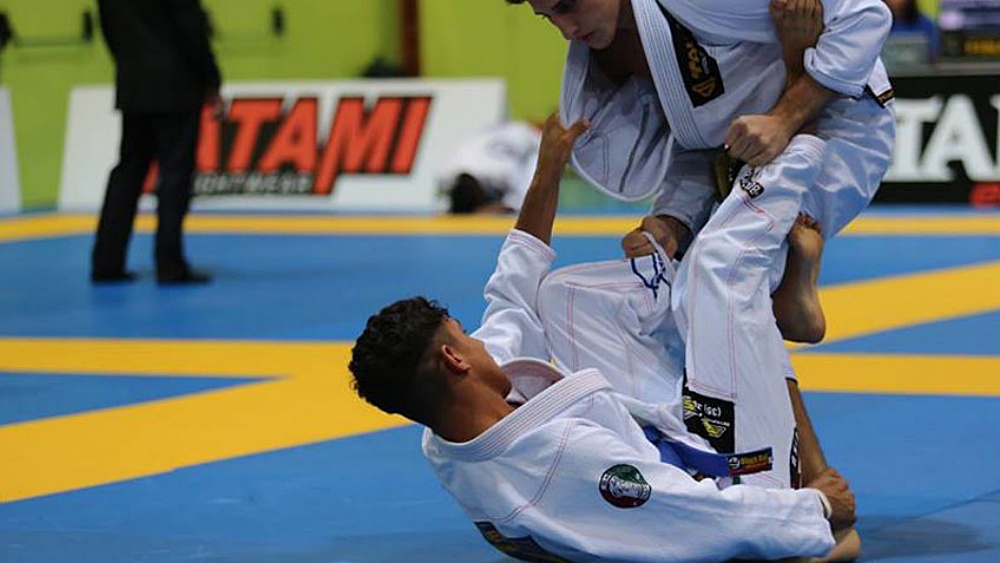The De La Riva guard is a classic and highly useful position in Brazilian Jiu-Jitsu and has been used for many decades. Known for its versatility and dynamic sweeping opportunities, this technique, named after the legendary Ricardo De La Riva, is a common guard you see in academies all over the world. If you are a newbie in the position, learning a few fundamental sweeps from the De La Riva guard can significantly enhance your ability to sweep the opponent over. This article will explore several options you can do from the De La Riva guard.
Before we review techniques you can do from the guard, let’s first discuss the basics of the De La Riva guard position. To define, the De La Riva (DLR) guard is an open guard variant where you position yourself at a slight angle and control an opponent’s leg using your own (known as the De La Riva hook).
Your other leg can push against their other leg, and your hands typically control their sleeves, collar, or foot. This position offers control over your opponent’s balance and movement and opens the door for sweeps using kuzushi (off-balancing) techniques.
At its core, the DLR guard is a Gi-specific technique requiring specific gripping mechanics to be effective. However, in the past couple of years, more and more BJJ competitors have started implementing the De La Riva guard in No-Gi, grappling with slight modifications in their grips. Regardless of how it is used, the De La Riva guard is a proven technique that will be useful from the white to black belt level.
5 Sweeping Options From De La Riva Guard
In this video, 2x Brazilian Jiu-Jitsu Black Belt World Champion Teco Shinzato shows 5 essential De La Riva sweeps.
The first technique is the wrestle-up from the DLR guard. Use your hook from the De La Riva guard to force the opponent over your head, forcing them to post on the mat. As they do, attack the opponent by grabbing their legs to initiate a wrestle-up. Finish the technique by doing a low double or knee-tap takedown.
The second technique is a sweep using the sitting DLR guard. Assuming you are using your leg to hook against the opponent’s right leg, use your left leg to push the opponent as you sit up. Grab the opponent’s collar and sleeve as you sweep them over using your legs. This may seem like a complicated move, but it can be surprisingly effective even against larger opponents.
The third technique is another wrestle-up variation, this time from the DLR to the sitting guard transition. Do not forget to grab the opponent’s sleeve before you go for the attack to prevent them from posting on the mat to regain balance.
The fourth technique is a single-leg takedown from the De La Riva guard. Transition to the situp guard and do a technical standup while maintaining control of the opponent’s leg. Once you are completely upright, you can finish the takedown using any single-leg finish you prefer. For beginners, using the “running the pipe” finish can be a nice option since it is simple enough to do.
The last technique in the video is the DLR sweep using the top Gi grip. Transition to the situp guard as you grip against the opponent’s jacket (around the shoulder or back area). Pull them to the side while you kick against their leg to complete the sweep.
Notice that some of these sweeps do not start and end in the actual De La Riva position. This is common in many techniques, especially when playing variations of the open guard. It is recommended that you study the situp guard alongside the DLR guard to make your transitions seamless.
Control Mechanics For The No-Gi De La Riva Guard
We decided to also include a basic introduction to the No-Gi De La Riva guard, as many have adopted it in the past years. In this video, BJJ black belt and competitor Junny Ocasio shares his approach to the technique.
He mentions that the initial grips to the No-Gi DLR are a little different, and it is a must to maintain tension against the leg at all times. He likes to place his hips near the opponent’s foot as he loops his leg around the opponent’s. A critical step in his version is using both hands to control the leg while moving his knee at an angle to off-balance the opponent. These control tactics can make your guard that much stronger. It will also make it easier for you to transition to other guards as needed. The video did not demonstrate any sweeps. For now, learning the control mechanics should be enough for most beginners and intermediate practitioners.
Additional Tips
Like with all techniques we share, investing time and effort to practice the De La Riva guard is critical. While white belts can gain a lot of value from this position, it is considered an intermediate technique. It can be very nuanced, especially when discussing gripping transitions and shifting in body weight. With this, drilling the position (from the basic entries to the sweeps) becomes super important. Drill the position and techniques we went over today as consistently as you can, preferably with a trusted training partner. Assess your performance and slowly add them to your game once you become more comfortable.
Conclusion
The De La Riva guard is a powerful tool in Brazilian Jiu-Jitsu, offering a range of sweeping options. These five sweeps provide a solid foundation for beginners to start experimenting with and incorporating into their game. Each sweep has its unique mechanics and ideal scenarios, so practice them regularly to understand when and how to use them effectively. Remember, consistent practice and refinement are the keys to mastering any BJJ technique. With time and dedication, these De La Riva sweeps can become an excellent part of your grappling toolbox.
You may also like:

















